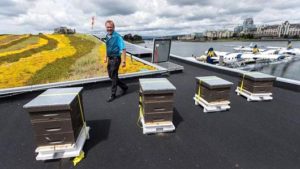Best Practices at the Greenest Airports

Source: Harbour Air
Did you know that Chicago’s O’Hare Airport has an apiary? It is home to a million bees! Denver International’s 10 MW solar farm is complemented with the airport’s own composting facility. The largest green wall in North America is at Vancouver International. Not surprisingly, the Galapagos Islands’ airport is net zero, using solar and wind to power its operations. It also desalinates sea water to provide potable water for the airport.
There are lots of distinctions and accolades in this dynamic field! SFO has implemented more than 49 different energy efficiency measures. There’s rainwater harvesting at the Indira Gandhi Airport in Delhi, plus daylight harvesting, and onsite solar and sewage treatment plants.
Mexico City’s planned airport will be the most sustainably built. Its design lacks a conventional roof, traded it in for a continuous lightweight grid shell in a single flowing form. The entire building will be serviced from beneath, collect rainwater and provide incredible views of planes circling above, featuring a radical new form of structure that is open to the skies above.

Planned Mexico City’s Sustainable Airport
San Diego International touts the world’s first LEED Platinum airport terminal, while LAX boasts the world’s largest LEED certified terminal. Long Beach Airport is proud of its unique and purposeful lack of passenger jetways. They use lots of air conditioning and deprive those arriving in sunny Long Beach of the outdoor experience. Many airports have converted their runway lighting to LED; most airports have addressed the long-hanging fruit of efficiency gains in their terminals, energy-intensive facilities. Getting passengers to and from the airports has long been a focus of airport efficiency.
But the greenest of them all… according to one study, is Oslo’s Airport. In addition to a terminal built with locally sourced stone and timbers from sustainably managed forests, the airport features a snow capture system that, like an ice house of yesteryear, provides summertime cooling!
Finally, airport facilities use only 5% of the energy used by the planes themselves. That’s according to the Airports Council International (ACI). According to the Intergovernmental Panel on Climate Change (IPCC), aviation emissions – from fuel used on planes – account for 2% of global GHG emissions.
